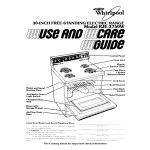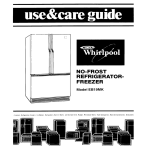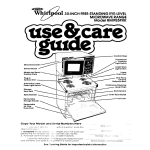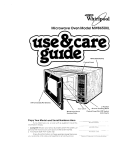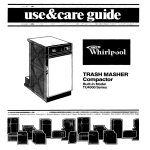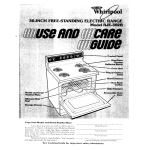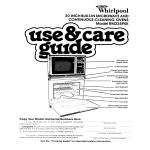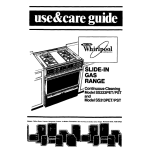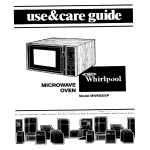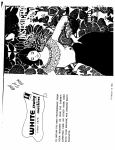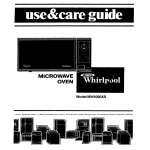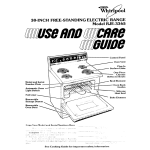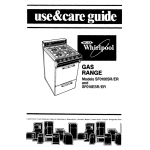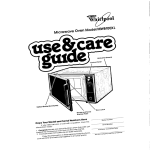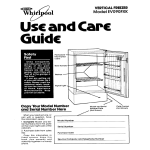Download Whirlpool RM275PXK User's Manual
Transcript
3CMNCH BUILT-INMICROWAVE AldO
Model and Seri
Number Plate
n Rack Guides
Fiberglass Heat Seal
Copy
Your Model
and Serial Numbers
If you need service,
information
ready:
or call with a question,
Here
have this
1. Complete
Model and Serial Numbers (from the plate
behind the microwave
oven door on the oven frame).
2. Purchase date from sales slip (or date installed).
just
Copy this information
in these spaces. Keep this book,
your warranty and sales slip together in a handy place,
See the “Cooking
Guide”tor
important
Model
Number
-~Serral Number
Purchase:lnstallatlon
Service
safety
Company
Date
and Phone
Information.
Number
“’
Your responsibilities.. .
Proper installation
and safe use of the ovens are your personal
responsibilities.
Read this “Use and Care Guide” and the “Cooking
Guide”carefully
for important
use and safety information.
Installation
You must be sure your oven is...
l
l
installed and leveled in a wall
that will hold the weight;
installed in a well-ventilated
area protected
from the
weather;
l
properly connected
to the correct electric SUDDIV and
Proper use
You must be sure your oven is...
l
l
l
used only for jobs expected
of home ovens;
used only by people who can
operate it properly;
properly
maintained.
Contents
irse Meal :;ensc I rc:rci .‘I-:“. = -‘r(3bf
C;ean!nq-“eMlc:ri-ti,
.cw... r
Inioortatit Infornatlon
How Mlcrcwave
Over
.‘v-~~
B, Level Oven Racr
Using Your Lower Oven
Setting the Clot k
ilstng the MlTute Tamer
T”le Lotier Oven Contra ,c
Baking or Roastrny
4djusting the Oven Tc?rrlperature Control
Jsing the Automatic
IdEALIIMER Clock
FIroilIng
Broiling Chart
The Oven Lights
The Oven Vents
Cleaning
and Caring for Your Oven
Control Panel and Knobs
The Lower Oven Self-Cleaning
Cycle
Cleaning
Chart
The Optional Rotlsserle
If Yocl Need Service or Assistance
I. Before Calling for Assistance
.,
2. f You Need Assistance
3. If You Need Servtce
4 If You Have a Problerr
3
Using your microwave upper oven
Microwave
Probe
Signal
Oven Controls
Light
Meal Sensor
Probe Control
Digital
Cook
Timer
Power Control
Start Button
Tmk
SETTING THE CONTROLS
Be sure You understand
the basics of microwave
oven cooking before you start.
Start with recipes from Your MtCRO MENUS Cookbook.
Follow the directions
carefully.
NEVER START THE OVEN WHEN IT’S EMPTY. The oven can be damaged.
For testing,
use at least a cup of water.
Be sure you have read and
understand
the dlrections.
1.
Put food in the oven.
4.
Set cooking times longer
than 10 minutes by turning the timer knob and
wheel. First set the knob,
then move the wheel.
Example: to set 22 minutes, 30 seconds...
0 Set 2 minutes, 30 seconds by pushing in and
turning knob.
l Set 20 minutes
by pushing up on wheel.
DEFROSTING
For defrosting, set Cook
Power Control to DEFROST
(MED-LO) setting. See the
Defrost Guide inside the oven
door or your MICRO MENUS’
Cookbook
for suggested
defrost times.
Tmk
2.
Close the door. Make
sure it locks. The oven
won’t work if the door isn’t
closed tightly.
3.
Set cooking times up to 10
minutes by pushing in
the timer knob and turning clockwise.
The oven
light will goon, Push in
and turn counterclockwise
to reduce time.
5.
Set Cook Power to
desired setting from HI to
LO. Some recipes require
different Cook Powers
for best results. (See
chart]
6.
Push the START Button. The
oven light will stay on.
You will hear a fan running during oven
operation.
When the set time is up,
the oven will shut off automatically.
You will hear
a bell, the light will go off
and the fan will stop.
-COOK
POWER CHARTRecipes in the
MICRO MENUS, Cookbook use Cook Power
settings from HI to LO.
Recipes in other books
and magazines
may
use different percentages of cooking
power.
The following
chart will
be helpful:
HI - 100% of full power
MED-HI - 70% of full
power
MED - 50%offull
power
MED-LO - 30% of full
power
(DEFROST)
LO - 15% of full
power
TO STOP THE OVEN
1.
Push in and turn the timer
knob counterclockwise
to
0o:oo.
OR
2.
Open the oven door.
TO RESTART THE OVEN
1.
2.
3.
Close the oven door.
Set timer (If needed).
Push the START Button.
5
THE MEAL SENSOR” TEMPERATURE PROBE
Roast or bake meats or casseroles
to a set temperature
instead of by time.
When the Meal Sensor Temperature
Probe is properly
used, the microwave
oven
will turn off automatically
when the probe senses the temperature
you set.
For casseroles, the tip of
the probe should be in
the center of the food. Stir
foods when recommended. Replace the
probe
&fk
Sensor
For liquids, balance
the
probe on a wooden spoon
or spatula so the tip of the
probe is in the center of
the liquid
For roasts, the tip of the
probe should be in the
center of the largest muscle, but not touching fat or
bone.
I
,_
Socket
L
1.
Insert at least 13 of the
temperature
probe into
the food.
2.
Place food in the oven
and plug the probe into
the socket on the oven
wall. The Probe Signal
Light will come on.
3.
Make sure the probe does
not touch any part of the
oven Interlor. Close the
door.
4.
Set the Cook Power if
desired.
5.
M ove the Meal Sensor
pointer to the final cooking temperature
you
want.
6.
Push the START Button
When the probe senses
the cooking temperature
a buzzer sounds, and the
oven turns off
DO...
l
l
l
l
l
6
use hot pads when removing
probe from
food or food from oven.
unplug probe from socket to turn off oven
light.
stir foods during cooking when
recommended.
stir soups, casseroles
and drinks before
serving.
cover roasts with foil and let stand a few
minutes after cooking
Remove foil if you
decide to cook it longer
DON’T...
l
l
l
l
l
l
let probe or probe cable touch any part of
the oven interior.
let probe touch foil (if used) Foil can be
kept away from probe with wooden toothpicks. Remove foil if arcing occurs.
use paper, plastic wrap or plastic containers. They will be in the oven too long.
use probe in regular oven.
force probe into frozen food.
use probe for foods that need to simmer.
.Tmk
MEAL SENSOR?: TEMPERATURE PROBE GUIDE
Food
Cook Power
Setting
Meal Sensor
Setting
Tips
Beverages
HIGH
165-F to
170-F
170 F
Balance
Canned
HIGH
Food
Casseroles
MEDIUM HIGH
170 Fto
175 F
Chowders
MEDIUM HIGH
180 F
Dips
Meat Loaf
(beef)
MEDIUM
140 F
probe
on wooden
spoon.
Use MEDIUM Cook Power for very thick
foods such as baked beans.
Use MEDIUM Cook Power for very thick
mixtures. Stir once or twice.
Balance probe
once or twice.
on wooden
spoon.
Stir
MEDIUM
170 F
HIGH
Do not use the Meal Sensor probe when cooking poultry. Because of the
amount of bone and shape of poultry, there is no place where the meat is
thick enough to place the probe properly.
110-F
MEDIUM
Place sandwich
on paper napkin.
Insert probe from side so tip is in center
of filling.
Thick sandwiches
work best.
Poultry
Sandwiches
HIGH
soup
165 Fto
170 F
Balance probe
once or twice.
on wooden
spoon.
Stir
TIPS
l
l
l
l
in several of the items -all
not heat at the same rate.
Casseroles
cooked using the MEAL SENSOR
probe should be made from precooked
foods. Do not use raw meats, raw vegetables and cream sauces in casseroles.
Dry casseroles
l
do not work well
l
Thaw frozen casseroles
and meats in the
microwave
oven before inserting the
probe.
If you are cooking individual
servings such
as mugs of soup, check the probe setting
CLEANING
l
Dry meat loaf mixtures
the mugs may
don’t work well.
Remember
that roasts may vary in size,
shape and composition.
Use the timings for
minutes per pound as a guideline
as well as
the MEAL SENSOR probe.
Starchy vegetables
SENSOR probe.
tend to stick to the MEAL
THE PROBE:
1 Remove probe from microwave
oven using hot pads.
2. Wipe probe with a hot sudsy cloth. Use a plastic scouring pad to remove stubborn foods
not immerse probe in water or wash in the dishwasher. Be careful not to kink the cable.
Do
Tmk
7
CLEANING THE MICROWWE
Wipe often with warm sudsy
water and a soft cloth or
sponge.
UVEN
For stubborn soil, boil a cup
of water in the oven for 2 or 3
minutes. Steam will soften
the soil.
Do not use abrasive
cleaners
IMPORTANT
Before you start using your microwave
information
Metallic
Glaze
Metallic
’
will help you avoid
p.
/
/
or steel wool pads.
INFORMlUION
oven, read this section
carefully.
This
to your oven.
Trim
“z,‘rTie
Cooking in metal containers
can damage
the oven. So
can containers
with hidden
metal (twist-ties, foil-lining,
staples, metallic glaze or
trim). Test dinnerwore
wure before using.
damage
Be sure to clean the areas
where the door and oven
frame touch when closed.
Rinse well.
or cook
Paper can char or burn
and some plastics can
melt if used when heating
foods for more than 4
minutes.
To lest u dish for safe use, put it
into the oven with a cup of
water beslde it. Cook on high
Cook Power for one minute.
If the dlsh gets hot and the
water stays cool, do not
use It.
NEVER start a microwave
oven when it’s empty. The
oven can be damaged
If
you experiment,
put a
container
of water In the
oven.
NEVER COOK OR REHEAT A
WHOLE EGG. Slice hard
boiled eggs before
heating. Steam build-up in
whole eggs may cause
them to burst and possibly
damage
the oven.
Don’t let anything touch
the top of the oven cavity.
Continued
8
next page
Rough or harsh cleaners
DO NOT store things in the
can scratch or dull the
oven finish. DO NOT USE THEM.
Overcooking
some foods
can cause them to scorch
or flame...especially
foods
like potatoes, popcorn,
snacks, etc. See the
MICRO MENUS
Cookbook.
.Tmk
Make popcorn
only In
poppers designed
for use
in microwave
ovens.
Follow popper directions.
Results are the popper
manufacturer’s
responsibility.
Liquids heated in certain
containers
may overheat.
The liquid may then splash
out with a loud noise. This
does not harm the oven,
but you should not use
such containers to heat
liquids again.
DO NOT OVERCOOK
POTATOES. At the end of the
recommended
cooking
time they should be
slightly firm. Wrap in foil
and set aside for 5 minutes
They will finish cooking
while standing.
USE HOT PADS. Microwave
energy does not heat
containers,
but the hot
food does.
Follow MICRO MENUS.
Cookbook
directions
carefully. If using a
different cookbook,
you
may need to experiment
with times and Cook
Powers.
It is normal for the inside of
the oven door to look wavy
after the oven has been running for a while.
l
l
If your electric power line
voltage is less than the
normal 240 volts, cooking
times may be longer
Tmk
Double-check
settings.
all
Use the oven only for
defrosting, cooking
or
reheating.
Do not be concerned
if you
hear a tan running during
or after cooking in the
lower oven. A fan automatically turns on to help
protect the microwave
oven from excess heat.
HOW MICROWWE
OVENS WORK
Microwave
ovens are safe. Microwave
energy is not hot. It causes
make its own heat, and it’s this heat that cooks the food.
Stirrer
Maanetron
food to
Oven ‘Cavity
Meta I Botiom
Microwaves
are like TV
waves or light waves. You
can’t see them, but you can
see what they do.
A magnetron
produces
microwaves.
The microwaves
move into the oven where
they are scattered
around by
a stirrer (like a fan).
Microwaves
bounce off
metal oven walls and are
absorbed
by food.
The glass bottom of your
microwave
oven lets microwaves through. Then they
bounce off a metal floor,
back through the glass bottom and are absorbed
by the
food.
Microwaves
pass through
glass, paper and plastic
without heating them so food
absorbs the energy. Microwaves bounce off metal pans
so food does not absorb the
energy.
Microwaves
may not reach
the center of a roast. The heat
around the outside is what
cooks the roast all the way
through. This is one of the
reasons for letting some
foods (roasts, baked potatoes] stand for a while after
cooking, or for stirring some
foods during the cooking
time.
The microwaves
disturb
water molecules
in the food
As the molecules
bounce
around bumping
into each
other, heat IS made, like rubbing your hands together.
This is the heat that cooks.
BI-LEVEL
OVEN RACK
Use the Bi-Level Oven Rack to stack foods when cooking in more than one container,
The rack can be turned upside-down
to help fit taller containers
on the bottom of the
oven.
First Position: Use the rack only when heating
more than one container
of food.
Do not let a container
touch the top of the
oven.
Second Position: Turn rack upside-down
when using a taller container
on the bottom
of the oven.
CLEANING
l
l
l
10
THE RACK
Wash by hand with a mild detergent.
Wash on the top rack of a dishwasher.
Do not use abrasive scrubbers
or cleansers
SPECIAL CAUTIONS
l
l
l
l
l
Do not use with browning
dish.
Use only when cooking foods in more than
one container.
Do not use in conventional
ovens or under
broiler.
Do not let food or container touch the top of
the oven.
Do not store rack in the oven.
Using your lower oven
lower Oven Controls
Stop Time Knob
Automatic
Minute
MEALTIMER-
CloCk
j
Timer
Start Time Knob
Temperature
Control
Oven Signal
Light
Oven
Selector
Manual Oven
Light Switch
1.
Push in Minute Timer Knob and turn
clockwise
until clock
digits show the right
time
-Tmk
of day.
2.
let the Minute
Timer Knob pop out. Turn
counterclockwise
until the Minute Timer
dial is on OFF. If you push in on the knob, you
will change
the time of day.
11
USING THE MINUTE
1.
TIMER
Without pushing it in, turn the Minute Timer
Knob until the setting showing in the
window is longer than the one you want.
2.
Turn the knob back so the setting
want shows in the window.
you
3.
When the set time is up, a buzzer
will sound.
4.
Turn the dial to OFF to stop the buzzing.
THE LOWER OVEN CONTROLS
The lower oven is controlled
by two knobs: the Oven Selector and the Oven
Temperature
Control. Both must be on 0 sethng for the oven to heat.
THE OVEN SELECTOR
With the Oven Selector on
BROIL, only the top element
heats. (Broiling, pg. 15).
With the Oven Selector on
BAKE, the bottom element
does most of the work. The
top element heats, but does
not turn red. [Baking, pg. 13)
With the Oven Selector on
TIMED BAKE, the MEALTIMER’
Clock can be used to turn the
oven on and off automatically.
(MEALTIMER Clock, pg.14).
THE OVEN TEMPERATURE CONTROL
Use the Oven Temperature
Control to set baking or roasting temperature
when the
Oven Selector is on BAKE or
TIMED BAKE.
When both the Oven Selector and Temperature
Control
are on BROIL, the broil element heats all the time. The
Oven Temperature
Control
can be set on a temperature
for slower broiling (see Broiling, page 15).
Tmk
BAKING OR ROASTING
1 I’
Lift ra ck at front and pull out
Set the Oven Selector
BAKE.
on
Put the rack(s) where you
want them before turning on
the oven.
Rack(s) should be placed
so food can be centered
in
the oven. Always leave at
least 1’ 2 to 2 inches (4-5 cm)
between the sides of the pan
2nd the oven walls and pans.
For more information,
see the
“Cooking
Guide.”
Let the oven preheat until the
Signal Light goes off
Set the Oven Temperature
Control to the baking
temperature
you want.
6
During baking, the elements
will turn on and off to help
keep the oven temperature
at the setting. The Signal Light
will turn on and off with the
elements.
The top element helps heat
during baking, but does not
turn red.
Put food in the oven. Oven
rock,
walls ond door
ADJUSTING
When baking is done, turn
both knobs to OFF.
will be hot.
THE OVEN TEMPERATURE CONTROL
Does your new oven seem to be hotter or colder at the same
old oven? The temperature
setting in your old oven may have
ally over the years. The accurate
setting of your new oven can
If you think the oven temperature
needs adjusting,
follow these
OFF
1.
Pull out the center
of the Oven Temperature Control.
2.
Locking Screw
Loosen the locking screw.
Tighten
the locking
Tooth
settings than your
changed
graduseem different.
steps:
Notches
3. To lower the tem-
screw.
OFF
perature, move
black ring so tooth
is closer to LO, Each
notch equals
about AOF [SC).
Replace
the knob.
4.
Tooth
Notches
To raise the temperature, move
black ring so
tooth is closerto
HI. Each notch
equals about 10°F
(5°C).
13
USING THE AUTOMATIC
MEALTIMER
CLOCK
The Automatic
MEALTIMER Clock is designed
to turn the lower
at times you set.. even when you are not around
To start and stop baking
automatically:
1.
Put the lower oven rack(s)
where you want them
and place the food In the
oven.
2.
4.
Push in and turn the Stop
Time Knob clockwise
to the time you want the
oven to shut off
5. Set the Oven Selector
7.
After baking is done,
both knobs to OFF
To stop baking
turn
Make sure the clock is set
to the right time of day.
on
TIMED BAKE.
8.
3.
6.
Push in and turn the Start
Time Knob clockwlse
to the time you want bakrng to start
Set the Oven Temperature
Control on the baking
temperature
you want
To stop the oven before
the preset time. turn both
knobs to OFF
automatically:
1,
Put the oven rack(s) where you want
them and place the food in the oven
2.
Make sure the clock IS set to the right time
of day
Push In and turn the Stop Time Knob clockwlse to the time you want the oven to shut off
3.
oven on and off
4.
5.
Set the Oven Selector on TIMED BAKE.
Set the Oven Temperature
Control on the
baking temperature
you want.
6. After baking is done, turn both knobs to OFF.
7. To stop the oven before the preset time,
turn both knobs to OFF.
SPECIAL CAUTION:
Use foods that will not go bad or spoil
while waiting
for cooking
to start. Avoid
using dishes with milk or eggs, cream
soups, cooked
meats or fish, or any item
with baking powder or yeast.
Smoked or frozen meats may be used;
so can vegetables,
fruits and casseroletype foods. Vegetables
can be cooked
in
14
a covered
baking dish with about a halfcup (118 ml) of water for 1 to 1% hours.
Any food that has to wait for cooking
to
start should be very cold or frozen before
it is put in the oven. MOST UNFROZEN
FOODS SHOULD NEVER STAND MORE THAN
TWO HOURS BEFORE COOKING STARTS.
BROILING
1.
Place the rack where
want it for broiling.
you
2.
Put the broiler pan and
food on the rack.
3.
Set the Oven Selector
BROIL.
4.
Set the Oven Temperature
Control on BROIL (or on a
lower temperature
for
slower broiling).
5.
During broiling, the oven
door must be partly
open. A built-in stop will
hold it there
6.
When broiling is done,
turn both knobs to OFF.
Control
on a temperature.
For slower broiling, set the Oven Temperature
instead of BROIL. The broil element will then turn on and off instead of staying
The lower the temperature
setting, the slower the broiling.
The Oven Selector
must be on BROIL and the door partly
Suggested
oven-rack
Food
Beef
positions
open for all brolllng
and broiling
on
on.
temperatures.
times
Approximate
Temperature
1st side
Minutesset to BROIL
2nd side
Description
inches (cm] from top
of food to Broil Element
l”(2.5 cm)
1 ” (2.5 cm)
1 ” (2.5 cm)
3” [B cm)
3” (8 cm)
3” (8 cm]
7-9
9-l 1
11-13
3-5
4-7
5-7
1 ’ 2” (4 cm]
1 12” (4 cm]
1 12” (4 cm]
12” (1 cm)
4”-5”
4”-5”
4”-5”
3” (8
13-l 5
17-19
19-21
6-8
6-8
8-l 0
14-16
4-5
l”(2.5 cm)
1~“-1”
(I-2.5 cm)
’ 2” (1 cm)
3 4“-1 ”
(2-2.5 cm)
2-3 lb.
(l-l .5 kg)
cut in half
whole
fillets
3” (8 cm)
6-8
4-5
3” [8 cm]
3” (8 cm]
6-8
6
4-5
4
Steaks
Rare
Medium
Well done
Beef Steaks
Rare
Medium
Well Done
Hamburgers
Lamb Chops
Medium
Ham slice, precooked
or tendered
Canadian
Bacon
Pork Rib or Loin Chop
Well done
Chicken
Fish
Liver
Frankfurters
12”-3
4”
(1-2 cm)
(1 O-l 3 cm)
[ 1 O-l 3 cm]
[ 1 O-l 3 cm]
cm]
4”-5” [ 1 O-l 3 cm]
15
10
7 “-9” ( 18-23 cm)
3”(8 cm)
3”(8 cm)
25-30
11-16
7-8
1 O-l 2
9-14
5-7
3”(8 cm]
4”-5” [ 1 O-l 3 cm]
3
6-7
3
4-5
15
The lights
THE MICRO-
OVEN LIGHT
The light in the microwave
oven comes on when the oven door is open, when
you set the cooking time, when the oven is on, and when the temperature
probe
is plugged
into the socket.
THE LOWER OVEN LIGHT
The lower oven light will come on when you open the oven door or when you
push the Oven light switch at the bottom of the control panel. Close the oven
door or push the switch again to shut it off
To replace
the light bulb:
I
1.
Turn off the electric
at the main power
power
supply.
2.
Remove the bulb cover
by pulling out on the wire
holder and moving it to the
side.
3.
Remove the light bulb from
its socket.
4.
Replace the bulb with a
40-watt appliance
bulb
available
from most grocery, variety and
hardware
stores.
5.
Replace the bulb cover
and snap the wrre holder
in place. The bulb must
have this cover when the
oven is being used.
6.
Turn the power back on
at the main power supply.
The oven vent
Hot air and moisture get out of
the lower oven through
a vent just above
the oven door.
Do not block the vent.
Poor baking can result.
Cleaning and caring for your oven
CONTROL PANEL AND KNOBS
1.
16
First make sure
knobs are on OFF
then pull knob
straight off.
2.
Use warm soapy
water and a soft
cloth to wipe the
panel. Rinse and
wipe dry.
3. Wash knobs in warm
soapy water. Rinse
well and dry.
4. Push knobs straight
back on. Make sure
they are on OFF.
THE LOWER OVEN SELFXLERNING
CYCLE
The lower oven self-cleaning
cycle uses very high heat to burn away
soil. Before you start, make sure you understand
exactly how to use
the cycle safely.
BEFORE YOU START
1.
Y
Clean areas that may not be cleaned
during the cycle. Use hot water and detergent or a soapy steel-wool pad on...
l the frame
around the oven
l the inside
of the door, especially
the
part outside the oven seal.
DO NOT try to clean the fiberglass
seal. DO
NOT move it or bend it.
Wipe out any loose soil or grease.
SPECIAL CAUTIONS
DO NOT block the vent
during the cleaning
cycle
Arr must move freely for
best results
DO NOT use commercral
oven cleaners in your oven
Damage
to the porcelain
finish may occur.
DO NOT touch the oven
during the cleaning
cycle
it can burn you
DO NOT force the Lock
Lever. The lever is designed
to stay locked until the
oven is cool enough to
safely open.
DO NOT use foil or other
liners in the oven. During
the cleaning
cycle, foil
can burn or melt.
This will
SETTING THE CONTROLS
1.
Set the Oven Selector
CLEAN.
4.
Push in the Stop Time
Knob and turn the hand
clockwise
about two
or three hours. (Two hours
for light soil; three or
more for heavier soil.)
7.
The Lock Light
when the oven
above normal
temperatures.
Lever can’t be
when the Lock
10.
to
comes on
gets
baking
The Lock
moved
Light is on
2.
Set the Oven Temperature Control to CLEAN.
3.
Make sure the clock and
start and stop time dials
all have the right time
of day.
5.
Lift the panel between
the oven doors.
6.
Move the Lock Lever o/l
the woy to fhe right. The
Clean Light will come on
only when the lever is
all the way over.
When the Lock Light
goes off, turn the Oven
Selector and Temperature Control to OFF.
9.
Move the Lock Lever
back to the left. Do not
force it. Wait until it will
move easily. This turns
off the Clean Light.
a.
Atter the oven is cool,
wipe off any residue
or ash with a damp
cloth. If needed, touch
up spots with cleanser or
soapy steel-wool pad.
DO NOT TOUCH THE OVEN DURING THE CLEANING
18
CYCLE. IT CAN BURN YOU.
SPECIAL TIPS
1.
Keep the kitchen well
ventilated
during the
cleaning
cycle to help
get rid of normal heat
odors and smoke.
4.
Oven racks lose their shine, discolor
and become harder to slide on their
guides when they are left in the oven
during the cleaning
cycle. To make
them slide easier, polish the edges of
the racks and rack guides with a soapy
steel-wool pad, rinse well, and wipe
on a thin coat of salad oil.
2.
3.
Clean the oven before
it gets heavily soiled.
Cleaning
a very soiled
oven takes longer and
results in more smoke
than usual.
5.
If the cleaning
cycle
doesn’t get the oven as
clean as you
expected,
the cycle
may not have been set
long enough. Set the
cleaning
time longer
for heavier soil.
To stop the cleaning
cycle after it has
started :
l Turn the Stop fime
Knob clockwise
until the hand points to the right time
of day.
l Turn the Oven
Selector and Oven
Temperature
Control to OFF.
l When the oven
cools, move the Lock
Lever back to the left. DO NOT FORCE
IT.Wait until it moves easily.
During the self-cleaning
cycle, the oven gets much hotter than it does
for baking
or broiling...approximately
875’ F (468- C). This heat breaks
up grease
and soil, and burns it off.
The graph shows approximate
temperatures
and times during a selfcleaning
cycle set for two hours.
SELF-CLEANING
CYCLE -TWO
[Approximate
START
‘/z hr.
1 hr.
Temperatures
1% hrs
HOUR SETTING
and Times)
2 hrs.
Notice that the heating stops when the two-hour setting
while longer for the oven to cool down enough to unlock.
427
C
204
C
2% hrs
is up, but that it takes a
19
CLEANING CHART
PART
Porcelainenamel broiler
pan and grid
Control knobs
WHAT TO USE
Warm, soapy water or
soapy steel wool pads
Warm, sudsy water and
bristle brush
Warm, soapy water
Commercial
alass cleaner
Self-Cleaning
Oven cycle
Warm, soapy water or
soapy steel wool pads
Control
panel
Oven
racks
Lower oven
door glass and
outside only of
microwave
oven
Self-Cleaning
Oven
Warm, soapy water or
plastic scrubbing
pad
Commercial
glass cleaner
l
l
l
l
l
l
l
l
l
l
HOW TO CLEAN
Wash with other cooking utensils.
Do not place in Self-Cleaning
Oven.
Wash, rinse and dry well.
Do not soak.
Wash, rinse and dry with soft cloth
Follow directions
with cleaner.
Leave in oven during Self-Cleaning
cycle.
Wash, rinse and dry. Use soapy steel wool pads
for stubborn areas.
Make certain oven is cool. Wash, rinse and dry
well with soft cloth.
Follow directions
provided
with cleaner.
For areas outside SelfCleaning
area use warm,
soapy water or soapy steel
wool pads
* Clean before using Self-Cleaning
cycle to
prevent burn-on of soil.
l Follow
directions given on page 17, “The Lower
Oven Self-Cleaning
Cycle.”
l
Do not use commercial
oven cleaners.
Do not use foil to line the bottom of your Self-Cleaning
Oven.
THE OPTIONAL ROTISSERIE
If you would like a rotisserie for your oven, you can order a kit (Part No. 261881)
from your dealer The kit includes easy installation
instructions.
20
*
f
4@?
If you need service or assistance,
we suggest you follow these four steps:
1 Before
l
calling for assistance.. .
Performance
problems often result from
little things you can find and fix yourself without tools of any kind.
If nothing operates:
Is the oven correctly wired into a live circuii
with the proper voltage? (See Installation
Instructions.)
l
Have you checked
the main fuse or circuit
breaker box?
If the microwave
oven will not run:
l
Is the timer set?
l
Is the Cook Power set?
l
Is the door firmly closed and latched?
l
Did you push the START Button?
l
Did you follow the directions on pages 5
and 6 exactly?
If microwave
cooking times seem too long:
l
Is the electric supply to your home low or
lower than normal? Your electric company
can tell you if the line voltage is low.
l
Is the Cook Power at the recommended
setting?
l Are you allowing
for more time when cooking more food at one time?
If the microwave
oven turns off too soon or
not soon enough when using the probe:
l
Is at least ‘3 of the probe in the food?
l
Is the probe tip in the center of the food?
l
Is the probe touching bone or fat?
l
Have you allowed
roasts to stand for a few
minutes after cooking?
l
Is the probe plugged
tightly into its socket?
l
Is the Cook Power set where it should be?
l
Is the Meal Sensor Probe Control set at the
end temperature
you want?
l
If the lower oven will not operate:
Is the Oven Selectorturned
to a setting
(BAKE or BROIL, but not TIMED BAKE]?
l
Is the Oven Temperature
Control turned to a
temperature
setting?
If the Self-Cleaning
cycle will not operate:
l Are the Oven
Selector and the Oven Temperature Control set to “CLEAN?”
l
Does the Start TTme Dial show the correct
time of day?
l
Is the Stop fime Dial set ahead to the time
you want the cleaning
cycle to stop?
l
Is the Lock Lever all the way to the right?
(The Clean Light will come on.]
If cooking results aren’t what you expect:
l
Is the oven level?
l Are you using
pans recommended
in the
Cooking Guide?
l
If baking, have you allowed 1’ 2to 2 inches
(4-5 cm) on all sides of the pans for air
circulation?
l Does the oven temperature
seem too low or
too high? See pagel3,
“Adjusting the oven
temperature
control.”
l
Have you preheated
the oven as the recipe
calls for?
l Are the pans the size called
for in the
recipe?
l Are you following
a tested recipe from a
reliable source?
See the Cooking Guide for more information
on cooking problems and how to solve them.
l
Tmk
21
2
l
If you need assistance”‘. . .
Call the Whirlpool
COOL-LINE * service assistance telephone
number. Dial free from:
Continental
U.S. . . . . . . . . (800) 253-1301
Michigan
. . . . . . . . . . . . . . . . (800) 632-2243
Alaska & Hawaii . . . . . . . . (800) 253- 1121
and talk with one of our trained Consultants.
The Consultant can instruct you in how to obtain satisfactory
operation
from your appliance or, if service is necessary,
recommend
a
qualified
service company
in your area.
3
l
If you need service”‘. . .
Whirlpool
has a
nationwide
net-.
work of franchised
TECH-CARE ” Service
Companres.
TECH-CARE service
technicians
are
't'wK)L
trained to fulfill the
1sr
7
product
warranty
ikP. t
and provide
afterwarranty
service,
anywhere
in the United
States. To locate TECH-CARE service
in your
area, call our COOL-LINE service assistance
telephone
number (see Step 2) or look in your
telephone
directory
Yellow Pages under:
jL,AL
APPLIANCES-HOUSEHOLDMAJOR-SERVICE
8 REPAIR
WklRLPOOLAPPLlANCES
FRANCHISEDTECH~CARESERVICE
ELECTRICALAPPLIANCESMAJOR-REPAIRING
OR
.';EH\.If
XYLSERVICECO
'23 Maple
.SEHI~IC E (‘O.lf/'.i
.\ ,E.i
XYISERVICECO
499~9Q99
121 Maple
8 PARTS
tiHIRLPOOLAPPLIANCES
FRANCHISEDTECh CARESERblCE
b c fJL1P.l \ll;\
999~9999
OR
WASHING MACHINES,
8 IRONERS-SERVICING
DRYERS
WHlRLPOOLAPPLlANCES
FRANCHISED TECH-CARE SERVII E
.SEHl /('I:
XYZSERVICE CO
'23 Maple
4
l
( O.lf/'4.\,h\
999.9999
Ifyou have a problem”‘. . .
Call our COOL-LINE service assistance
telephone number (see Step 2) and talk with one
of our Consultants, or if you prefer, write to:
Mr. Guy Turner, Vice President
Whirlpool Corporation
Administrative
Center
2000 US-33 North
Benton Harbor, Ml 49022
If you must call orwrite, please provide: model
number, serial number, date of purchase, and
a complete
description
of the problem.
This
information
is needed
in order to better respond to your request for assistance.
22
THIS PAGE
INTENTIONALLY
LEFT
BLANK
FSP is a registered
trademark
of Whirlpool
Corporation
for
quality parts. Look tor this
FSP
symbol of quality whenever
,~ you need a replacement
part
’ for your Whirlpool
appllonce.
FSP replacement
ports
will fil right and work right, because
they are
made to the some exacting
speclflcotions
used to build every new Whirlpool
appliance.
0
Benton Harbor, Michigan. Automatic Washers, Clothes Dryen,
Freezers. Retrigerator-Freezers.
Ice Yaksrs, Dtatnvashers,
BUilt-in IhEnS and Surface U)ailS. flanges, #cro+vava Owens,
Compactors, Room Air Condtifoners, Dstt~miditkrs.
Central
Healiflg and Air Conditimxing Systeins.
Part No. 311421 Rev. A
Printed in U.S.A.
























